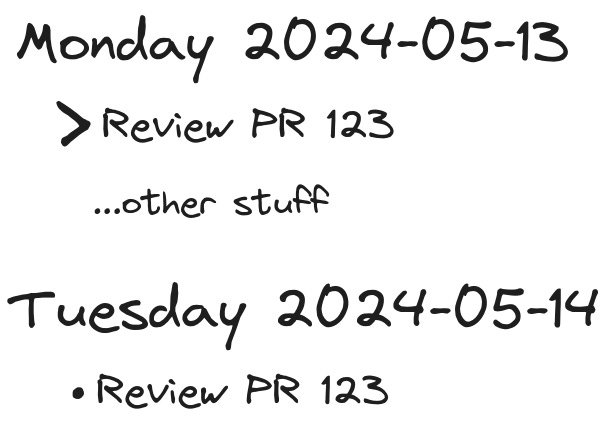Bullet Journal For Software Engineers: How To Remember Everything And Increase Your Productivity (Part 2)
The Daily Migration.

In the previous part of this series, we understood the basics of the BuJo method and applied it to the Software Engineer’s daily job.
We discussed the core principles for using notes, tasks, and events. By now, it should be clear how events give context to notes and tasks. You should also know how to mark bullets as “important”.
But there are still some open questions like:
Why should you mark notes as important?
Who is reminding you about your tasks? Should you go through the pages to find them?
The list goes on, probably.
In this and the following posts, I will answer those and other questions until we develop a routine to be more effective with our tasks and to get the best out of our notes.
The Daily Migration
The Daily Migration is the core of my BuJo experience.
My working day starts with the Daily Migration. When I go to my desk, the first thing I do is turn on my laptop, and the second one is open my notebook and write down the current day below the last note of the previous one. I also leave an empty line so the separation between the days is clearer.
At that point, I look at the page with yesterday’s notes.
1. Tasks Migration
Tasks migration is the first routine I apply every day.
I look at all the tasks I wrote the previous day. If I completed the task, I do nothing; if I didn’t, I write the task for the new day and mark the task for the previous day with ”>.”
At the end of this migration, you should have all your tasks from the previous day marked with an “x” so completed or with “>” so migrated. All the migrated tasks will appear at the top of the new day.
Tasks might accumulate.
If tasks accumulate, migrating them might become boring. But that’s useful. As you watch your task list grow, you will feel motivated to complete them instead of migrating them.
IMPORTANT: Don’t migrate the symbol “!” with the tasks!
Tasks With A Date
My BuJo will not contain all the tasks that should be completed on a specific date or at a specific time.
Consider an example where, on Monday, you are in a meeting with your team. During the discussion, you are asked to schedule a new meeting to discuss something related. What you do, as we know, is write a new task on your BuJo like:
Schedule meeting next Monday, repository pattern.
You didn’t get the chance on Monday or forgot about that task, so you didn’t schedule the meeting. On Tuesday, you wake up and migrate your tasks. Once you reach the meeting task, you can do one of two things:
Schedule the meeting on the calendar immediately and mark the task as completed.
Migrate the task.
Both options work perfectly, even if the first one is better since you don’t procrastinate on a five-second task.
The problem is when you schedule the meeting on the calendar and add a new task on your BuJo:
Meeting on Monday, repository patter.
You will migrate that task every day for a week with no chance of marking it as completed. This is the same for doctor’s appointments and any other task with a specific date.
All the tasks with a specific date should be on your calendar, not your BuJo.
2. Tasks Prioritization
Priorities might change, and your routine should reflect that.
What appeared important yesterday might not be so relevant today. If yesterday something was not urgent, today it could be your highest priority. That’s why, in the previous routine, I told you not to migrate the “!” symbol while migrating tasks.
Tasks are marked “important” during the Tasks Prioritization.
After you migrate all the tasks to the new day, it is time to decide what is important today. This is what some people call the “daily quest.” The idea is that you should be aware that you might not be able to do everything you have to do in a day.
If you can complete your important tasks, that should be enough to feel good.
So, during the Tasks Prioritization, you should look at your tasks and think how important every single task is. You can also look at the previous day’s notes and see if you marked that task as “important,” but don’t give too much attention. You should decide if a task is important today.
Before you mark all your tasks as “important”, let me tell you this:
If you have more than three priorities, you have no priorities.
From Good to Great, by Jim Collins
For this reason, consider this rule: you can only mark two tasks a ““importa” t” daily.
This does not mean you only have to complete two tasks every day. Ideally, you want to complete all of them, but you might not be able to. That’s why you need priorities.
If you can’t do everything, at least do what’s important.
3. Notes Reflection
Journaling is not just about tasks. It’s a habit that can help you reflect and look at your thoughts differently. Notes are your thoughts, ideas, and considerations. Usually, when you think about something and remember that, it doesn’t give you the same feelings as the first time. When you read something you wrote, on the other hand, you can remember how you felt the moment you wrote it.
That is what happens during the Notes Reflection.
Once I have migrated all my tasks, I usually feel relieved. I know my tasks are safe, and I won’t forget anything. This is when I can truly concentrate on my thoughts and my emotions.
Read the notes of the previous day.
What do you think while reading them? How do you feel about what you wrote? Does something make you angry? Does it make you satisfied? Is there a problem you couldn’t solve yesterday, or do you have new ideas?
Write it down on the current day.
Old notes will generate new notes. But the main part of the process is reflecting on yourself. Many people fall into the burnout trap without even realizing it. Ideas also get refined, and rethinking a problem might bring you closer to a solution.
Reflect on yourself and listen to your emotions.
Read Next:
How to categorize books as a Software Engineer and maximize your knowledge
Reading books is a crucial part of my life as a Software Engineer. I still remember buying the first book related to Software Engineering: Clean Code by Robert C. Martin. I read a lot of online content, but I couldn’t imagine living without books. Books offer a different perspective and, often, a deeper view of some to…
6 rules to improve your life working remotely
Working remotely has great benefits: you can have lunch with your family, your schedule is usually more flexible, no time wasted in the traffic, and others. It also has drawbacks which, if not properly addressed, can make your life more stressful. The web is full of stories of people burned out because they worked several …





